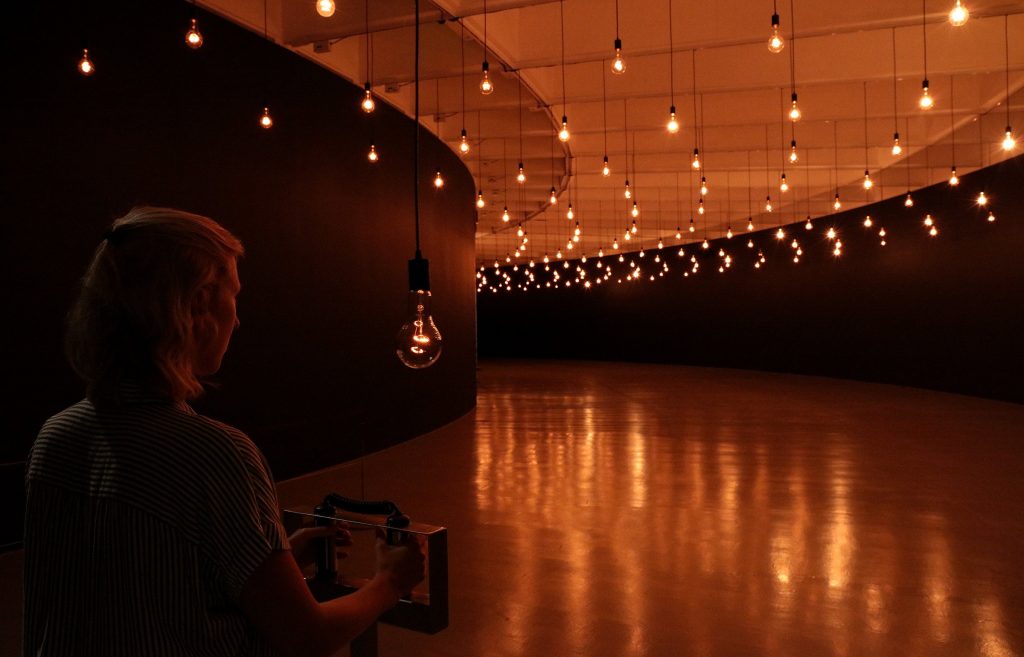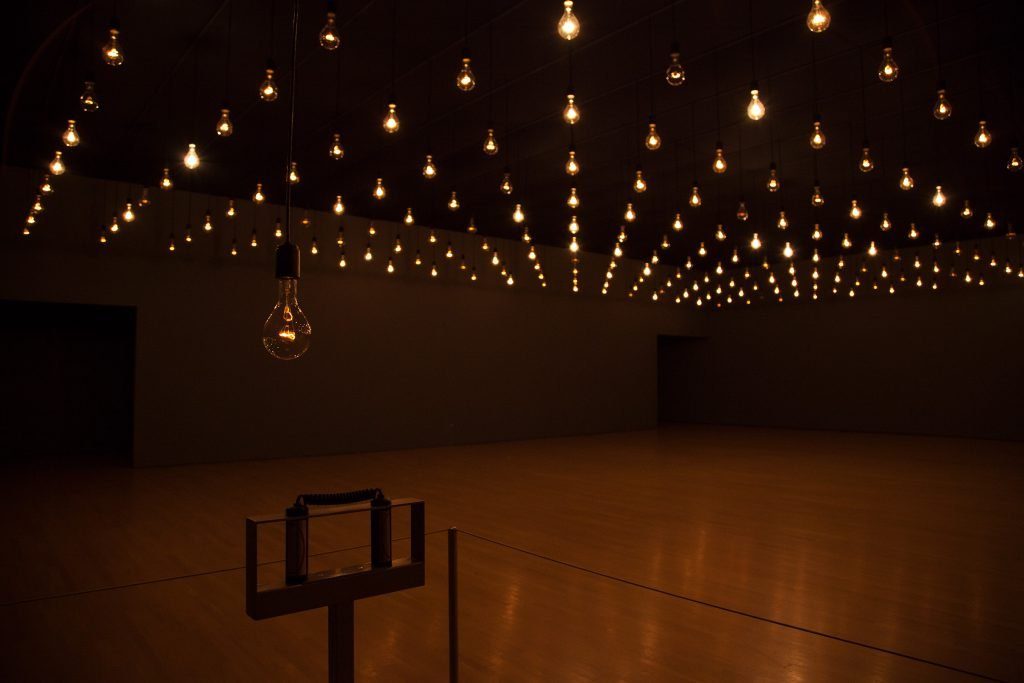Pulse Room is an interactive installation by Rafael Lozano-Hemmer, which features 300 clear incandescent light bulbs, 300 W each and hung from a cable at a height of three metres. The bulbs are uniformly distributed over the exhibition room, completely filling it. An interface placed on a side of the room has a sensor that detects and records the heart rate of participants via their pulse, and converts it into light flashes shown by incandescent light bulbs. At any given time the room shows the heartbeat of the 100 most recent participants.

How It Works
When someone holds the interface, a computer detects the participant’s pulse and immediately sets off the closest bulb to flash at the exact heart rhythm. When the interface is released, all the lights turn off briefly and the flashing sequence advances by one position down the queue, to the next bulb in the grid. Each time someone touches the interface, a heart pattern is recorded and this is sent to the first bulb in the grid, pushing ahead all the existing recordings. At any given time, the installation shows recordings from the most recent participants.
There are two renditions for this interactive piece, a 100 bulbs and 300 bulbs version. Within both works, Lorenzo-Hemmer uses incandescent light bulbs, voltage controllers, heart rate sensors, computer and metal sculpture as part of his building materials for the clean and immaculate execution.
Materials used:
- Incandescent light bulb
- Voltage controller
- Heart rate sensors
- Computer
- Metal sculpture sensor stand
- DMX circuit board
- Dimmer packs
(Hemmer, R. L. (n.d.))
Artwork in Collaboration with:
Programmer–Conroy Badger
Production support–David Lemieux, Natalie Bouchard, and Pierre Fournier
Technicians
(Hemmer, R. L. (n.d.)).
Public Receptivity & Thoughts
The first work of his three-part installation: “Pulse” series, the Pulse Room works upon the concept of subverting intimacy between participants and their familiarity with their own bodily data through publicly displaying information that is supposedly deemed as ‘sensitive’ and ‘personal’. Through this broadcasted display of intimate bodily information, participants are invited to be a part of an experience where they thread between feelings of familiarity vs foreignness, evoking a sense of intrigue and alternative perspective as though they are looking at the self through another lens.
Another two other famous pieces from his “Pulse” series is the Pulse Tank and Pulse Index. where biometric data from participants’ pulses and fingerprints are utilised and transformed into beautiful visualisations of light and water.
“Pulse Tank” is an Interactive installation where the heart rates of members of the public are detected by sensors and converted into water waves in a ripple tank. A light show is created by the resulting waves and their interaction. To participate, insert your finger into one of the four cylinders on the side of the tank or put your hands flat on the front panel; the computer will detect your pulse and activate a solenoid which will hammer your heart rate onto the tank.
“Pulse Index” is an interactive installation that records participants’ fingerprints at the same time as it detects their heart rates. The piece displays data for the last 765 and over participants in a stepped display that creates a horizon line of skin. To participate, people introduce their finger into a custom-made sensor equipped with a 220x digital microscope and a heart rate sensor; their fingerprint immediately appears on the largest cell of the display, pulsating to their heart beat. As more people try the piece one’s own recording travels upwards until it disappears altogether —a kind of memento mori using fingerprints, the most commonly used biometric image for identification.
The project exists in a small plasma version which features a 58 inch HD screen hung in portrait mode and in a large projection version which can be as large as desired.
Reflection
Interestingly, the one thing people love about Lozano-Hemmer’ Pulse series is that these interactive pieces do not invade their personal space in threatening ways despite the public broadcasting of personal information such as heart rate and fingerprints. This is done through a careful curation of the space (context), and interactivity in mind, where people are actively participating in the process of exploration and creation rather than being self-conscious. This is a great reflection of Lozano-Hemmer’s personal mantra of prioritising participation in every interactive piece, where he believed that “It used to be all about the viewers waiting for artwork to inspire them. Now it’s the artworks that are waiting for people to feel, sense and inspire them.”

The entire concept behind the entire ‘Pulse’ series was really to explore the question and meaning of our existence, as seen in the Pulse Room where every bulb represented an individual, with the rhythmic light flashes representative of the unique heartbeat rhythm that belongs to an individual. Through using technology and different medium of light and kinetic creativity, participants form their own connection and interpretation with the interactive piece.
I personally find this artwork quite intriguing as it is a direct translation of the self; a part of you which you don’t usually think about on a daily basis, yet instrumental to your existence. A piece of you taken out of its bodily context, and projected visually to you and everyone else. Rhythmic and symphonic, Lozano-Hemmer has successfully merged the idea of bringing art and science together through this stimulating piece. I also really like the way he keeps his overall execution clean and ordinary at first glance. For example in the “Pulse Tank”, the still bed of water seemed just like any other tank of water until someone first tries to interact with it spontaneously. One person generates ripples in the water, and with multiple participants, a whole new different artwork is created through the complex patterns of interferences that cast intriguing shadows around the space. I also really appreciate that his art has no ‘pattern’; no actual predictability or restriction as to how his participants can behave or interact with his works. From his works, I feel that we can all learn from Lozano-Hemmer’s ability to make philosophical ideas somehow literal and transform the abstract to become weirdly real, hopefully with a surreal edge too.

You must be logged in to post a comment.